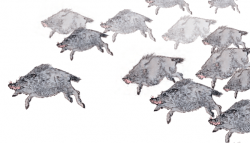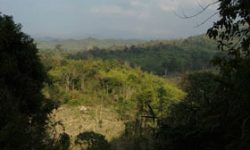Nature
Feeling the trees shivering: endangered environmental knowledge in northern Kyoto
For more than 400 years, villagers in the northern mountains of the Yamashiro basin (an area now incorporated to the modern administrative system of Kyoto city) have developed a special relationship with trees—in particular, with one specific type of tree, the cedar or Cryptomeria japonica, called sugi in Japanese.
Read MoreSix Thousand Lessons
During these years of travel, my understanding of what diversity means has changed. I began with an intuition, that the world was, from place to place and from culture to culture, far more different than I had been led to believe. Later, I began to understand that to ignore these differences was not simply insensitive but unjust and perilous.
Read MoreStone Wall
The Japanese countryside is full of stone walls. They are not freestanding grey lines used for dividing property but rather buttresses that hold back the mountains and shape them into something that can be lived on and farmed.
Read MoreEngineering the Japanese Islands
“Like all peoples on the planet, Japan has a complicated relationship with the natural world that’s shaped by religion and economic behavior and political practices, but certainly the notion that the Japanese enjoy a greener national philosophy is misguided. It does not hold up to historical scrutiny.”
Read MoreRescuing and Protecting Sumatra’s Critically Endangered Orangutans
The Orangutan Information Center (OIC) is a trail-blazing organization constituted of a team of dedicated Indonesian conservationists and veterinarians determined to save the critically endangered Sumatran orangutan from a host of threats…
Read MoreExcerpts from Whisper of the Land
“Let the photo-taking sessions be a ballet instead of a military-style attack or a grueling marathon. In the garden, drink the sun, sweep with the wind, sing like a bird, and dance with a shovel and a rake.”
Read MoreNature and Spirit Reunion
There is much work to be done—not only in “saving the Earth,” as the mantra of the environmental movement goes, but also in saving ourselves and our own souls in the process.
Read MoreWriters and the War Against Nature
Although human beings have interacted with nature – both cultivated and wild, for millennia, and sometimes destructively so, it was never quite like “war.” It has now become disconcertingly so…
Read MoreGrow Your Own Energy
In Japan the concept is often called “enerugi no chisan-chisho,” a phrase adopted from the local food movement. It directly translates… loosely as “grow your own energy.”
Read MoreSatish Kumar on Deep Ecology
Sometimes I came across a tree which seemed like a Buddha or a Jesus: loving, compassionate, still, unambitious, enlightened, in eternal meditation, giving pleasure to a pilgrim…
Read MoreNature and Culture in Japan
Japanese cultural tradition hides a vast storehouse of notions and practices that may be helpful in establishing a culturally-grounded eco-philosophy…
Read MoreFrontier Country: The political culture of logging and development on the periphery in Laos
In the last few years, an increasing amount of timber has been mined out of the frontier forests of Laos, nearly all of it bound for Vietnam…
Read MoreCurling
i have been a fern unfolding. in a forest of deep slanting shadows, close to the ground with its many tiny scratchings and slitherings, surrounded by the steady rumble and rush of a waterfall, i was a fern.
Read MoreMaverick Mushrooms
In Japanese, the general word for mushroom, kinoko, means “child of the tree.” Names of species then reflect specific trees plus the suffix –take (or dake), signifying “mushroom.”
Read MoreFireflies
When the summer nights begin to resemble a damp wool blanket thrown over our house and the rainy season pounds relentlessly onward, my husband and I like to drive out to a village in the nearby mountains…
Read More















